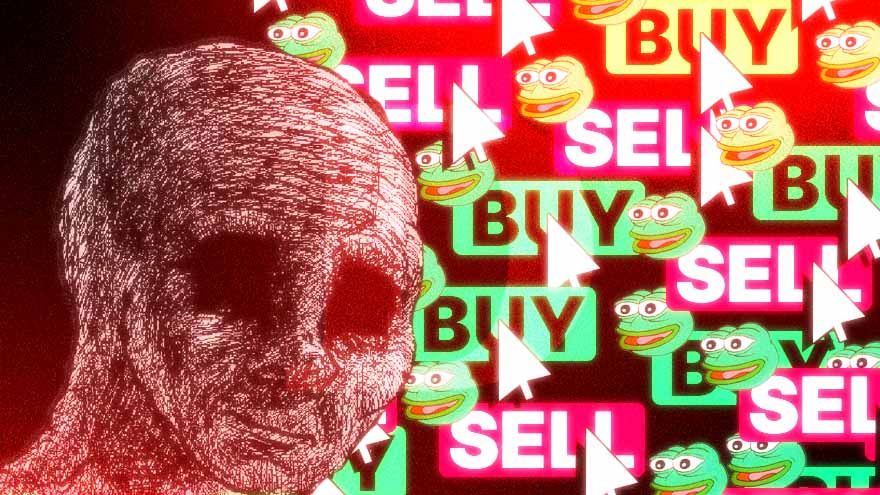[ad_1]
While early buyers of memecoins like PEPE, TURBO, and WOJAK, have enjoyed a great start to the month, the broader market has been losing ground.
BTC, ETH, and BNB, the largest three non-pegged digital assets, have all dropped over 5% in the past seven days.
Despite that, the memecoin craze has continued, with the tokens’ cashtags dominating social media and tickers trending on decentralized exchanges — GeckoTerminal, a data platform developed by CoinGecko, showed that four of the top five trading pairs by volume in the past day were memecoins.

At over $100M, LADYS, a token inspired by the recent craze around Milady NFTs, shows the second-highest volume of all trading pairs. A PEPE/WETH pair on Uniswap is the third-highest, with just over $78M in volume.
Retail Trap
Giorgi Khazaradze, CEO of Aurox, a software company which is developing a trading terminal, suggested that while memecoins were fun for some people, less sophisticated players are generally losing money on the assets.
“The insiders that are making bank, they’re drawing liquidity out of the rest of the market, the rest of the retail,” Khazaradze told The Defiant.
The CEO added that it takes a coordinated effort to push a token like PEPE to such a high market capitalization. “Getting a token, especially a meme token, to trend and to go up to a billion-dollar market cap is not easy,” he said.
Khazaradze added that the memecoin craze won’t make crypto look any better in the eyes of the SEC, which has been pursuing litigation against digital asset projects all year.
It’s generally not a sign of a healthy market when digital assets without use cases are topping charts. With tokens like PEPE, which emphasize their lack of utility on their website, valued higher than established DeFi tokens like Maker’s MKR, it raises the question of how useful these assets really are.

To be sure, the crypto market can’t entirely be written off as unhealthy — while some would say the attention and capital attracted by memecoins is a waste, Uniswap, PancakeSwap, and other decentralized exchanges (DEXs) are the ones facilitating the trades.
So while the memecoins traders are playing hot potato with may not provide lasting value, the DEXs that traders are using continue to show their worth.
Rug Pulls
Khazaradze found certain sophisticated players deploying memecoins on a regular basis and then systematically pulling liquidity from them. This is one kind of scam known as a “rug pull.”
Data provided by Aurox showed that the frequency of rug pulls is increasing. There were 140 rug pulls three weeks ago, 189 two weeks ago, and 279 in the past week, with the amounts drained getting larger each week, according to the data. In the past seven days alone, malicious developers have raked in over $90M.
In all, these are the dog days of crypto. Massive regulatory uncertainty persists, making it difficult for legitimate projects to confidently move forward with their roadmaps.
Khazaradze, who is planning to take Aurox public this year, says he constantly needs to change the language in his filings with the SEC as regulatory and enforcement actions take place.
“One of the reasons you go public is because you want to increase transparency and accountability,” he said. “These memecoins are the antithesis of that. Complete opacity and no accountability.”
[ad_2]
Read More: thedefiant.io









 Bitcoin
Bitcoin  Ethereum
Ethereum  Tether
Tether  XRP
XRP  Solana
Solana  USDC
USDC  TRON
TRON  Dogecoin
Dogecoin  Lido Staked Ether
Lido Staked Ether  Cardano
Cardano  Wrapped Bitcoin
Wrapped Bitcoin  Hyperliquid
Hyperliquid  Wrapped stETH
Wrapped stETH  Bitcoin Cash
Bitcoin Cash  Sui
Sui  Chainlink
Chainlink  LEO Token
LEO Token  Stellar
Stellar  Avalanche
Avalanche  Toncoin
Toncoin  USDS
USDS  WhiteBIT Coin
WhiteBIT Coin  Shiba Inu
Shiba Inu  WETH
WETH  Wrapped eETH
Wrapped eETH  Litecoin
Litecoin  Binance Bridged USDT (BNB Smart Chain)
Binance Bridged USDT (BNB Smart Chain)  Hedera
Hedera  Monero
Monero  Ethena USDe
Ethena USDe  Polkadot
Polkadot  Bitget Token
Bitget Token  Coinbase Wrapped BTC
Coinbase Wrapped BTC  Uniswap
Uniswap  Pepe
Pepe  Pi Network
Pi Network  Aave
Aave  Dai
Dai  Ethena Staked USDe
Ethena Staked USDe  OKB
OKB  Bittensor
Bittensor  BlackRock USD Institutional Digital Liquidity Fund
BlackRock USD Institutional Digital Liquidity Fund  Cronos
Cronos  Aptos
Aptos  Internet Computer
Internet Computer  NEAR Protocol
NEAR Protocol  Jito Staked SOL
Jito Staked SOL  sUSDS
sUSDS  Ethereum Classic
Ethereum Classic